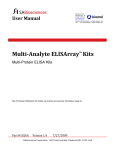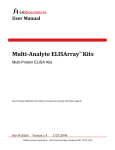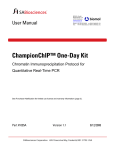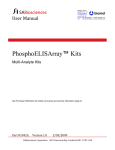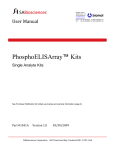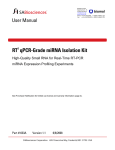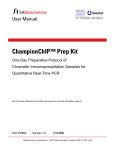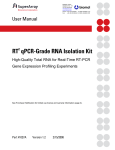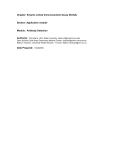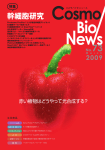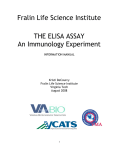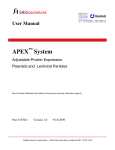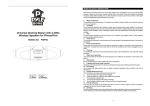Download User Manual - Biomol GmbH
Transcript
User Manual BIOMOL GmbH Waidmannstr. 35 22769 Hamburg [email protected] www.biomol.de Phone:+49-40-8532600 or 0800-2466651 (D) Fax: +49-40-85326022 or 0800-2466652 (D) Single Analyte ELISArray™ Kits Single Cytokine or Chemokine ELISA Kits See Purchaser Notification for limited use license and warranty information (page 3). Part #1025A Version 1.4 7/27/2009 Single Analyte ELISArray™ Kits Single Cytokine or Chemokine ELISA Kits User Manual (For Catalog Numbers Prefixed by SEH or SEM) Ordering and Technical Service Contact Information: Tel: Fax: On-line Order: E-MAIL: 1-888-503-3187 (US) 301-682-9200 (outside US) 1-888-465-9859 (US) 301-682-7300 (outside US) www.SABiosciences.com [email protected] (to place an order) support@ SABiosciences.com (for technical support) You may place orders by fax, e-mail or from our website. Each order should include the following information: Your contact information (name, phone, email address) Product name, catalog number and quantity Purchase order number or credit card information (Visa or MasterCard) Shipping address Billing address For more information, visit us at www.SABiosciences.com SABiosciences Corporation 6951 Executive Way Frederick, MD 21703 USA 2 CONTENTS I. Background and Introduction 4 II. Materials Provided 6 III. Precautions 6 IV. Additional Materials Required 6 V. Complementary Products 6 VI. Protocol 7 A. Sample Preparation and Handling 7 B. Reagent Preparation 8 C. Assay Procedure 9 D. Data Analysis VII. 11 Troubleshooting and Frequently Asked Questions 11 LIMITED PRODUCT WARRANTY This warranty limits our liability to replace this product in the event the product fails to perform due to any manufacturing defect. SABiosciences Corporation makes no other warranties of any kind, expressed or implied, including without limitation, warranties of merchantability or fitness for a particular purpose. SABiosciences Corporation shall not be liable for any direct, indirect, consequential or incidental damages arising out of the use, the results of use or the inability to use this product. NOTICE TO PURCHASER This product is intended for research purposes only and is not intended for drug or diagnostic purposes or for human use. Purchase of an ELISArray Kit does not grant rights to use or modify the kit components for resale or to use the ELISArray Kits to manufacture commercial products without written approval of SABiosciences Corporation. No other license, expressed, implied or by estoppels, is granted. U.S. patents may cover the use of certain antibodies included in the ELISArray Kit. Presently, it is not clear under U.S. laws whether commercial users must obtain licenses from the owners of the rights to these U.S. patents before using the ELISArray Kits. 3 I. Background and Introduction The Single Analyte ELISArray Kits are designed to quantitatively measure the amount of an individual protein analyte using a standard sandwich enzyme-linked immunosorbant assay (ELISA) technique. A target-specific capture antibody has been coated onto 8-well strips placed into a 96-well plate format. In addition to the pre-coated plate, the kit also includes the detection antibody, Antigen Standard, and a complete set of reagents for a colorimetric ELISA. The performance of other ELISArray kits currently on the market is limited by the quality of the antibody pair produced by their own company. SABiosciences’ ELISArray kits are developed with the best possible antibody pairs on the market. To develop these high-performance ELISArray kits for your research, we screen several antibody pairs from the market, comparing them side-by-side on signal intensity, specificity, and antigen response dynamic range. We choose the best possible pair in our formulation. Take advantage of our assay development and optimization expertise with the Single Analyte ELISArray Kits. The Single Analyte ELISArray Kits are quantitative sandwich-based enzyme-linked immunosorbant assays. (Figure 1 displays an overview of the assay protocol.) A capture antibody specific for a single protein has been coated onto the 8-well strips. Replicate serial dilutions of a standard for the protein of interest are added to one set of replicate strips, while replicate dilutions of unknown biological samples are added to other sets of strips. Incubation allows the capture antibody to bind the specific protein of interest. After washing away unbound protein, biotinylated detection antibody added to the wells also binds the captured analyte. After washing again to remove unbound material, an avidinhorseradish peroxidase conjugate is added. The wells are again washed and a colorimetric substrate solution is added, which produces a blue color in direct proportion to the amount of protein analyte present in the initial sample. The color development is stopped by adding stop solution, and the absorbance at 450 nm is read. The readings from the unknown samples are then compared to the standard curve to quantify the amount of protein in the original sample. Benefits of the Single Analyte ELISArray Kits: • High Performance: Low background. High sensitivity. Excellent linearity. • Easy to Use: No special equipment required, only the ELISA plate reader already in your lab Version 1.4 1. Prepare all reagents. Set up experimental samples, Antigen Standard, and negative control. 2. Add 50 µl assay buffer into each well of ELISArray plate. Transfer 50 µl of samples and serial diluted Antigen Standard into the appropriate wells of the ELISArray plate. Incubate 2 hours. 3. Wash three times. 4. Add 100 µl Detection Antibody Solution. Incubate 1 hour. 5. Wash three times. 6. Add 100 µl Avidin – HRP. Incubate 30 minutes. 7. Wash four times. 8. Add 100 µl Development Solution. Incubate 15 minutes in the dark. 9. Add 100 µl Stop Solution. Read OD 450nm within 30 minutes. Figure 1: Overview of the Single Analyte ELISA Kit Procedure. Total Time ~ 4.5 hours Technical Support: 888.503.3187 (US) 301.682.9200 5 II. Materials Provided: Component / Description BOX 1 Antigen Standard (1 µg/ml) Detection Antibody Avidin-HRP Conjugate 10% BSA Donkey Serum BOX 2 Capture Antibody-Coated 8-well strips Sample Dilution Buffer Stock Assay Buffer Stock Wash Buffer (10× Concentrate) Development Solution Stop Solution Quantity 1.5-ml tube 1.5-ml tube 1.5-ml tube 15 ml bottle 15 ml bottle One plate carrying 12 8-well strips 60 ml bottle 60 ml bottle 125 ml bottle 25 ml bottle 60 ml bottle Storage Conditions: Box 1 is shipped on dry ice or blue ice packs and should be stored in non-frost-free freezer at -20 °C upon receipt. Box 2 is shipped at ambient temperature and should be stored at 4 °C upon receipt. Do not use kit beyond the expiration date printed on the label. Store any unused 8-well strips from an opened pouch in a zip-lock bag at 4 °C. III. Precautions 1. The Development Solution is toxic if inhaled or swallowed. Avoid contact with skin. Keep container tightly closed when not in use. 2. Stop Solution is an acidic solution. Wear eye, hand, face, and clothing protection when using this material IV. Additional Materials Required: 1. Standard ELISA Microplate Reader Capable of measuring 450-nm absorbance with a 570-nm correction wavelength 2. Calibrated Multi-Channel Pipettor 3. Wash Bottle 4. Microcentrifuge Tubes 5. Laboratory Timer V. Complementary Products: Multi-Analyte ELISArray Kits 6 Version 1.4 VI. Protocol: Please read through this entire protocol before beginning your experiment. A. Sample Preparation and Handling: High quality input material is ESSENTIAL for obtaining good results. The most important prerequisite for any ELISA analysis experiment is consistent, highquality experimental samples. Therefore, the sample preparation and handling procedures are critical to the success of the experiment. Specimens should be clear, because residual traces of particulate matter, heme, lipids or other contaminants will interfere with the performance of the ELISA. Recommended Preparation Methods: High quality protein samples for the ELISA experiment must be prepared using one of the following methods, each specific for your biological sample: a. Cell Culture Supernatants: Remove any particulate material by centrifugation for 10 minutes at 1000×g and assay immediately, or aliquot and store samples at ≤ - 20 °C. Avoid repeated freeze / thaw cycles. b. Serum: Use a serum separator tube and allow samples to clot for 30 minutes before centrifugation for 15 minutes at 1000×g. Remove serum and assay immediately or store samples at ≤ - 20 °C. Avoid repeated freeze / thaw cycles. c. Plasma: Collect plasma using citrate, EDTA, or heparin as an anticoagulant. Within 30 minutes of collection, centrifuge for 10 minutes at 1000×g. Assay immediately or store samples at ≤ -20 °C. Avoid repeated freeze / thaw cycles. Technical Support: 888.503.3187 (US) 301.682.9200 7 B. Reagent Preparation: Use only polypropylene tubes for the antigen and detection antibody steps. Briefly centrifuge any 1.5-ml tube in the kit before opening it in order to collect its contents at the bottom of the tube. 1. ELISA Array Kit Reagents: a. Thaw the 10% BSA and Donkey Serum at room temperature. Store on ice. b. Bring the Wash Buffer Concentrate, Assay Buffer Stock, Sample Dilution Buffer Stock and ELISArray plate to room temperature. Do not remove the ELISArray plate from its pouch at this time. c. Once finished with each reagent, return it to its proper storage conditions. d. Keep all other kit components at their recommended storage temperature until recommended by the protocol. 2. Wash Buffer Visually inspect the Wash Buffer Concentrate to ensure that all components are in solution. If any precipitates are visible, briefly shake the bottle to suspend any precipitate. Dilute 50 ml of Wash Buffer Concentrate into de-ionized or distilled water (dH2O) to a final volume of 500 ml. Transfer to wash bottle. Keep at room temperature. 3. Assay Buffer Dilute 0.6 ml of 10% BSA into a final volume of 30 ml with Assay Buffer Stock. Keep at room temperature. 4. Sample Dilution Buffer: For cell culture supernatant samples, prepare Sample Dilution Buffer 1: Dilute 2 ml of 10% BSA into a final volume of 20 ml with Sample Dilution Buffer Stock. Store on ice. For serum or plasma samples, prepare Sample Dilution Buffer 2: Dilute 6 ml of donkey serum into a final volume of 20 ml with Sample Dilution Buffer Stock. Store on ice. 8 Version 1.4 C. Assay Procedure: NOTE: Very accurate and precise pipetting is critical to the reliability and consistency of any ELISA experiment. Make sure that all of your single- and multi-channel pipettors are calibrated before starting this protocol. Maintain incubation times and temperatures as consistent as possible across strips and experiments for best results. 1. Prepare Antigen Standard dilutions and sample dilutions: a. Just before use, thaw the Antigen Standards on ice for 20 minutes. Vortex gently to mix well. b. For cell culture supernatant samples, use Sample Dilution Buffer 1 to prepare dilutions. For plasma or serum samples, use Sample Dilution Buffer 2 to prepare dilutions. c. Prepare a serial dilution of the Antigen Standard (2000, 1000, 500, 250, 125, 61.5, and 31.25 pg/ml) in a set of eight 5-ml (12 x 75) polypropylene tubes as follows: i. Add 2495 µl of the appropriate Sample Dilution Buffer to the first tube, and 500 µl of the same buffer to each of the remaining seven tubes. ii. Add 5 µl of the Antigen Standard to the first tube to make 2000 pg/ml Antigen Standard. Mix well. iii. Generate a series of 1:2 dilutions by transferring 500 µl from the first to the second tube, mixing well and then repeating from the second to the third and so forth on up to the seventh tube, as demonstrated in Figure 2. iv. Do not add any source of Antigen Standard to the eighth tube to setup a required assay performed in the absence of antigen to determine the background signal. 500 µl 500 µl 500 µl 500 µl 500 µl 500 µl 5 µl Antigen Standard 2000 1000 500 250 125 62.5 31.25 0.0 pg/ml pg/ml pg/ml pg/ml pg/ml pg/ml pg/ml pg/ml Figure 2: Generating a 1:2 Dilution Series and Negative Control for a Standard Curve. d. A series of dilutions of sample should be prepared in similar fashion using the same sample dilution buffer. Choose your serial dilution series based on the expected concentration of the analyte in your samples. Technical Support: 888.503.3187 (US) 301.682.9200 9 2. Remove the ELISArray plate from its pouch. Using a multi-channel pipettor, add 50 µl of Assay Buffer into each well of the ELISArray plate. NOTE: For best results, add all samples and reagents carefully by touching the pipette tips to the side of the wells just above the bottom and allowing the dispensed volume to run down the well wall. Do not blow out the last drop of volume dispensed to avoid introducing bubbles into the wells. 3. Transfer 50 µl of either the Antigen Standard or your sample serial dilutions to the appropriate wells of the ELISA 8-well strips. Use multiple wells or strips to obtain replicate measurements. NOTE: Change your pipette tips with every addition to avoid cross-contamination of the wells. 4. Cover the plate and gently shake or tap the strips for 10 seconds to mix. Incubate for 2 hours at room temperature on your bench-top. 5. Warm the Development Solution and Stop Solution to room temperature in lab bench drawer protected from light. NOTE: Avoid prolonged exposure of the Development Solution to light or contact with water, air, or extreme temperature. 6. Dilute the Detection Antibodies just before the next step: Thaw the Detection Antibodies on ice for 30 minutes. Dilute 0.55 ml of Detection Antibody to a final volume of 11 ml with Assay Buffer. Mix well but gently. 7. Washing ELISA Wells Decant or aspirate the contents of the wells. Wash wells by filling with 350 µl of 1×Wash Buffer. Gently shake or tap the plate for 10 seconds to mix and follow by decanting or aspirating the solution. Blot the strips upside down on absorbent paper to remove any residual buffer. Repeat twice for a total of three washes. 8. Add 100 µl of Detection Antibody solution to each well. Cover and gently shake or tap the plate for 10 seconds to mix. Incubate 1 hour at room temperature on your bench-top. 9. Prepare Avidin-HRP: Just before use, thaw the Avidin-HRP Conjugate on ice for 20 minutes. Vortex gently to mix well. Add 11 l of the Avidin-HRP Conjugate to 11 ml of Assay Buffer. NOTE: Avoid prolonged exposure of the Avidin-HRP Solution to light. 10. Wash ELISA wells as in step 7. 11. Add 100 µl of Avidin-HRP to all wells. Gently shake or tap the plate for 10 seconds to mix. Incubate for 30 minutes at room temperature in the dark. 12. Wash ELISA wells as in step 7, except for a total of 4 washes. 10 Version 1.4 13. Just before use, transfer the needed amount of the Development Solution (100 μl per well plus extra for viscosity pipetting errors) from its original bottle into a clean multi-channel pipettor reservoir. NOTE: Use a different clean multi-channel reservoir for each solution to be dispensed. 14. Add 100 µl of the Development Solution to each well. Incubate the plate for 15 minutes at room temperature in the dark. 15. Add 100 µl of Stop Solution to each well. The color in the wells should change from blue to yellow. 16. Read absorbance at 450 nm within 30 minutes of stopping the reaction. If wavelength correction is available, subtract readings at 570 nm from the reading at 450 nm. NOTE: Subtracting the A450 reading by the A570 reading corrects for any minor optical imperfections in the ELISA plate. Uncorrected A450 readings may yield artificially high signals. D. Data Analysis: 1. Processing the Raw Data Typical absorbance values should range from 0.00 to 2.50. Calculate the mean (average) absorbance for each set of replicate standards and experimental samples. Subtract these values by the mean (average) background absorbance as determined from assays performed in the absence of antigen. 2. Standard Curve a. Plot the corrected mean absorbance for the standard on the y-axis against its concentration on the x-axis in a log-log graph for a seven-point standard curve. b. Calculate the best straight-line curve fit through the points on the graph within the linear dynamic range of the results. Do not include points at the low and high concentration extremes where the absorbance does not change greatly with differing concentration. 3. Determination of Unknowns a. Use the background-corrected mean absorbance of each dilution of each unknown experimental sample and the standard curve to determine the protein amount in the sample. b. If the experimental unknown samples have been diluted, the concentration read from the standard curve must be multiplied by the dilution factor. VII. Troubleshooting and FAQs If you have additional questions, please check our website (www.SABiosciences.com) for a more complete listing of Frequently Asked Questions (FAQs), or call our Technical Support Representatives at 1-888-503-3187 or 301-682-9200. Technical Support: 888.503.3187 (US) 301.682.9200 11 Single Analyte ELISArray™ Kits User Manual Part #1025A Version 1.4 7/27/2009 BIOMOL GmbH Waidmannstr. 35 22769 Hamburg [email protected] www.biomol.de Phone:+49-40-8532600 or 0800-2466651 (D) Fax: +49-40-85326022 or 0800-2466652 (D) 12












